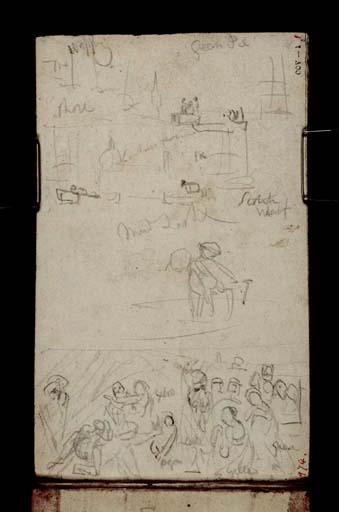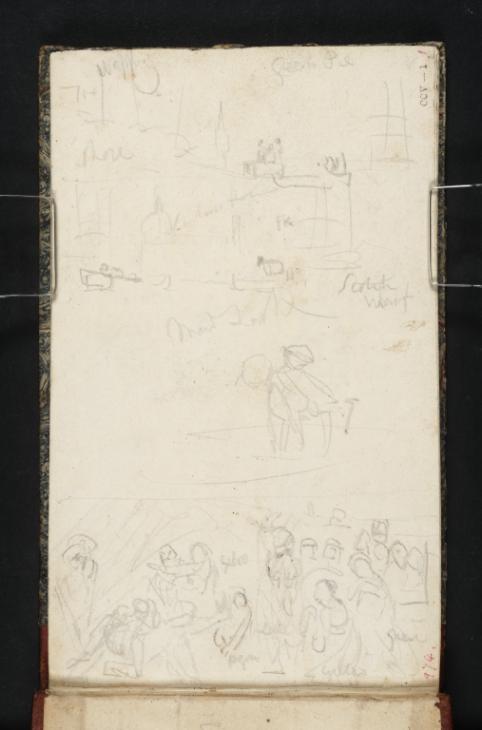Joseph Mallord William Turner Studies on the River Thames around Wapping; a Sketch Copy of Benjamin Robert Haydon's 'Raising of Lazarus' c.1823-4
Image 1 of 2
-
 Joseph Mallord William Turner, Studies on the River Thames around Wapping; a Sketch Copy of Benjamin Robert Haydon's 'Raising of Lazarus' c.1823-4
Joseph Mallord William Turner, Studies on the River Thames around Wapping; a Sketch Copy of Benjamin Robert Haydon's 'Raising of Lazarus' c.1823-4 -
 Joseph Mallord William Turner, Studies on the River Thames around Wapping; a Sketch Copy of Benjamin Robert Haydon's 'Raising of Lazarus' c.1823-4 (Enhanced image)Enhanced image
Joseph Mallord William Turner, Studies on the River Thames around Wapping; a Sketch Copy of Benjamin Robert Haydon's 'Raising of Lazarus' c.1823-4 (Enhanced image)Enhanced image
Joseph Mallord William Turner,
Studies on the River Thames around Wapping; a Sketch Copy of Benjamin Robert Haydon's 'Raising of Lazarus'
c.1823-4
Joseph Mallord William Turner 1775–1851
Folio 1 Recto:
Studies on the River Thames around Wapping; a Sketch Copy of Benjamin Robert Haydon’s ‘Raising of Lazarus’ c.1823–4
D17834
Turner Bequest CCV 1
Turner Bequest CCV 1
Pencil on white wove paper, 162 x 98 mm
Inscribed by Turner in pencil ‘Wapping’ top left, ‘Green [?Pil]’ top right, ‘shore’ and ‘Custom House’ towards top left, ‘Mud Lark’ centre, ‘Scotch | Wharf’ centre right, and ‘[?yellow]’, ‘Grey’, ‘Lake’, ‘[...]’, ‘yellow’ and ‘green’ towards bottom right across lower sketch
Inscribed by John Ruskin in red ink ‘974’ bottom left, ascending vertically, and ‘1’ top right, ascending vertically
Stamped in black ‘CCV – 1’ top right, ascending vertically
Inscribed by Turner in pencil ‘Wapping’ top left, ‘Green [?Pil]’ top right, ‘shore’ and ‘Custom House’ towards top left, ‘Mud Lark’ centre, ‘Scotch | Wharf’ centre right, and ‘[?yellow]’, ‘Grey’, ‘Lake’, ‘[...]’, ‘yellow’ and ‘green’ towards bottom right across lower sketch
Inscribed by John Ruskin in red ink ‘974’ bottom left, ascending vertically, and ‘1’ top right, ascending vertically
Stamped in black ‘CCV – 1’ top right, ascending vertically
Accepted by the nation as part of the Turner Bequest 1856
References
1909
A.J. Finberg, A Complete Inventory of the Drawings of the Turner Bequest, London 1909, vol.I, p.620, CCV 1, as ‘A crowd of figures, some struggling (probably sketch of Haydon’s “Raising of Lazarus”); also various sketches at “Wapping.”–“Mud Larks,” “Green Pie,”–“Scotch Wharf.”’.
1997
Anthony Bailey, Standing in the Sun: A Life of J.M.W. Turner, London 1997, p.240.
With the page turned vertically, Turner has made various slight studies of figures and boats on the River Thames foreshore, apparently at Wapping, as inscribed at the top left, on the north bank downstream from Old London Bridge, the subject of many drawings in this sketchbook; see the Introduction. The artist had inherited property in Wapping in 1820.1
At the bottom of the page is a rapid sketch of The Raising of Lazarus, an oil painting of 1821–3 by the ambitious but intransigent and financially disastrous historical painter Benjamin Robert Haydon (1786–1846). Haydon’s large, complex composition was exhibited at the Egyptian Hall, Piccadilly, London; here he rented a room and opened successfully to the paying public on 3 March 1823 after a private view two days earlier,2 continuing into April, when he was imprisoned for chronic debt.3 Turner’s watercolours for the Picturesque Views in England and Wales were exhibited at the same venue in 1829;4 the failure of another of Haydon’s self-funded exhibitions there in April 1846 was a factor in his suicide a few weeks later.5
In the first of its various indignities, Lazarus was sold to a creditor, ‘Binns, his upholsterer, for £300’ shortly after the 1823 exhibition,6 where Turner had presumably seen it and made this small sketch, less than 4 inches across compared with the painting’s dimensions of 427 x 636 cm (approximately 14 x 21 feet). This is a rare example of Turner’s copying a contemporary work,7 perhaps indicating a fellow-feeling for Haydon’s dedication and ambition, although the slightness of the memorandum is perhaps indicative of his critical opinion – but then Turner’s sketchbook copies of major Old Master works are usually equally perfunctory. Haydon’s picture was eventually presented to the National Gallery in 1868 and is now in storage at Tate (N00786), in a reasonably sound but much darkened condition.8 A crude anonymous copy in oils (Brighton and Hove Museums and Art Galleries) gives some idea of its original brighter tonality and the local colouring with which Turner has annotated his sketch. It is possible that some of the isolated figures on folio 28 verso (D17884) relate to Haydon’s painting.
On folio 44 recto (D17911) is Turner’s sketch of Rubens’s Chapeau de Paille, also exhibited in London in the spring of 1823.
Matthew Imms
December 2014
See Nicholas Powell, ‘Finance and Property’ in Evelyn Joll, Martin Butlin and Luke Herrmann (eds.), The Oxford Companion to J.M.W. Turner, Oxford 2001, p.108; see also Bailey 1997, p.240..
See Tom Taylor (ed.), Life of Benjamin Robert Haydon, Historical Painter, from his Autobiography and Journals, London 1853, vol.II, p.47.
See Taylor 1853, III, pp.306–23; and for Turner and Haydon generally, John McCoubrey, ‘War and Peace in 1842: Turner, Haydon and Wilkie’, Turner Studies, vol.4, no.2, Winter 1984, pp.2–7, and David Blayney Brown, ‘Haydon, Benjamin Robert (1786–1846)’ in Joll, Butlin and Herrmann 2001, p.136.
See Martin Butlin, ‘Copies after Other Artists’ in Joll, Butlin and Herrmann 2001, pp.63–4; and Ian Warrell, ‘“Stolen hints from celebrated pictures”: Turner as Copyist, Collector and Consumer of Old Master Paintings’ in David Solkin (ed.), Turner and the Masters, exhibition catalogue, Tate Britain, London 2009, pp.41–55.
See also Lydia Hamlett, ‘Sublime Religion: Benjamin Robert Haydon’s The Raising of Lazarus’, in Nigel Llewellyn and Christine Riding (eds.), The Art of the Sublime, January 2013, accessed 5 February 2014, http://www.tate.org.uk/art/research-publications/the-sublime/lydia-hamlett-sublime-religion-benjamin-robert-haydons-the-raising-of-lazarus-r1129549 .
How to cite
Matthew Imms, ‘Studies on the River Thames around Wapping; a Sketch Copy of Benjamin Robert Haydon’s ‘Raising of Lazarus’ c.1823–4 by Joseph Mallord William Turner’, catalogue entry, December 2014, in David Blayney Brown (ed.), J.M.W. Turner: Sketchbooks, Drawings and Watercolours, Tate Research Publication, April 2015, https://www

